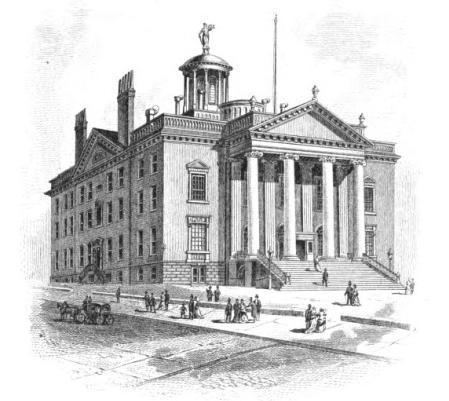Members 32 Members 128 | Party control Jacksonian (25-7) | |
 | ||
Term January 1 – December 31, 1833 President Lt. Gov. John Tracy (J) | ||
The 56th New York State Legislature, consisting of the New York State Senate and the New York State Assembly, met from January 1 to April 30, 1833, during the first year of William L. Marcy's governorship, in Albany.
Contents
Background
Under the provisions of the New York Constitution of 1821, 32 Senators were elected on general tickets in eight senatorial districts for four-year terms. They were divided into four classes, and every year eight Senate seats came up for election. Assemblymen were elected countywide on general tickets to a one-year term, the whole Assembly being renewed annually.
At this time, there were three political parties: the Jacksonian Democrats, the Anti-Masonic Party, and the National Republican Party.
The Anti-Masonic state convention met on June 21, and nominated again Assemblyman Francis Granger for governor and Samuel Stevens, of New York City, for lieutenant governor. They also nominated a full ticket of presidential electors, apparently composed of some supporters of William Wirt, and some of Henry Clay, but not pledged to any candidate.
The National Republican state convention met on July 26, Ambrose Spencer was chairman. They endorsed The Anti-Masonic nominees Granger and Stevens. They also endorsed the ticket of presidential electors nominated by the Anti-Masons, who—if they won the election—should vote for Henry Clay if this would help to defeat Jackson, otherwise for Wirt. In effect, both parties were in the process of merging, forming an Anti-Jacksonian bloc which eventually became the Whig Party.
The Jacksonian state convention met on September 19 at Herkimer, Samuel Young was chairman. They nominated U.S. Senator William L. Marcy for governor, and Judge John Tracy for lieutenant governor.
Elections
The state election was held from November 5 to 7, 1832. William L. Marcy and John Tracy were elected governor and lieutenant governor; and the Andrew Jackson/Martin Van Buren electoral ticket won.
State Senator John F. Hubbard (6th D.) was re-elected. John Sudam (2nd D.), Peter Gansevoort (3rd D.), Louis Hasbrouck (4th D.), John G. Stower (5th D.), Samuel L. Edwards (7th D.), John Griffin (8th D.) and Assemblyman Myndert Van Schaick (1st D.) were also elected to the Senate. Griffin and Hasbrouck were Anti-Jacksonians, the other six were Jacksonians.
Sessions
The Legislature met for the regular session at the Old State Capitol in Albany on January 1, 1833; and adjourned on April 30.
Charles L. Livingston (D) was re-elected Speaker with 99 votes against 22 for John C. Spencer (A-M).
On January 4, the Legislature elected State Comptroller Silas Wright, Jr. to the U.S. Senate, to fill the vacancy caused by the resignation of Gov. Marcy. Wright resigned the office of Comptroller on January 7.
On January 11, the Legislature elected Secretary of State Azariah C. Flagg to succeed Wright as State Comptroller. Flagg resigned the office of Secretary of State on January 12.
On January 15, the Legislature elected Adjutant General John Adams Dix to succeed Flagg as Secretary of State.
On February 4, the Legislature re-elected State Treasurer Abraham Keyser, Jr..
On February 5, the Legislature elected State Senator Nathaniel P. Tallmadge to succeed Charles E. Dudley as U.S. Senator for a six-year term beginning on March 4, 1833.
On February 21, the Legislature passed "An act for the construction of the Chenango Canal".
On March 23, the Legislature passed "An act authorising the appointment of an additional Canal Commissioner", and on April 4, the Legislature elected Michael Hoffman as such.
Districts
Members
The asterisk (*) denotes members of the previous Legislature who continued in office as members of this Legislature. Myndert Van Schaick changed from the Assembly to the Senate.
Employees
Assemblymen
The asterisk (*) denotes members of the previous Legislature who continued as members of this Legislature.
The party affiliations follow the vote on U.S. senators and other State officers on January 4, 11 and 15; February 4 and 5; and April 4.
